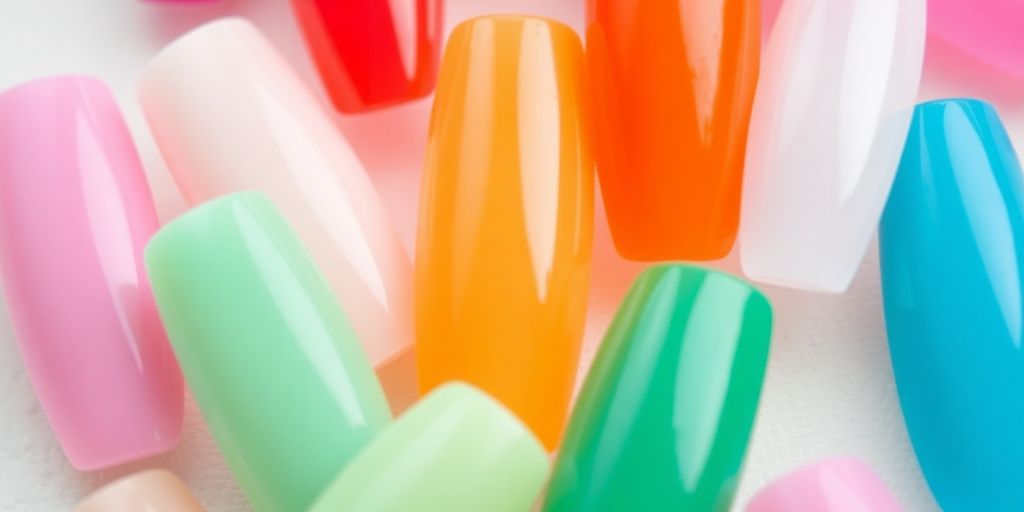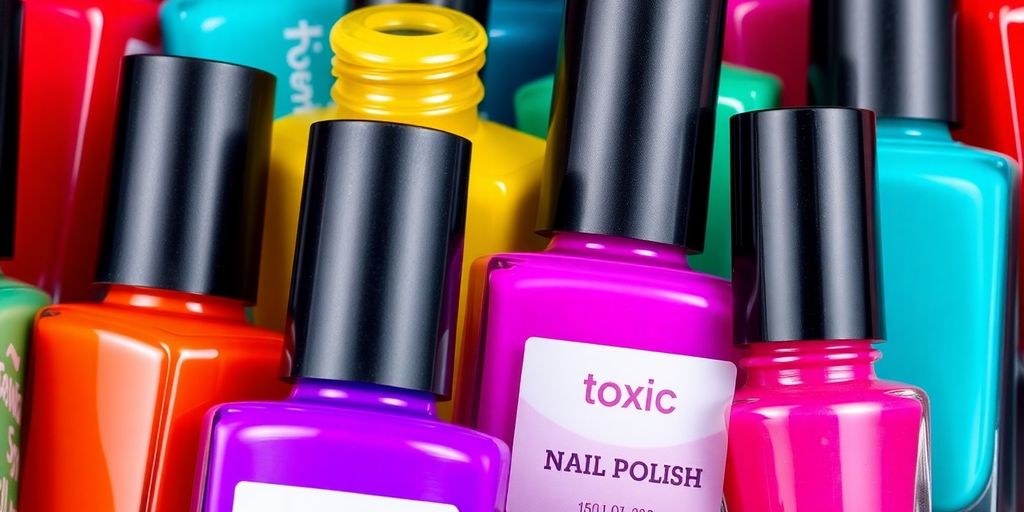In Nairobi, the quest for beautiful nails can sometimes lead us to products that might not be the best for our nail health. Many of us love the look of polished, strong nails, but some products can do more harm than good. It’s important to know what to avoid to keep your nails healthy and strong. Here’s a rundown of five nail products that are still being sold in Nairobi that you might want to steer clear of for the sake of your nail health.
Key Takeaways
- Nail hardeners can make nails brittle if used too often.
- Gel polish may weaken nails over time.
- Acrylic nails can cause nail damage if not applied properly.
- Nail glue often contains harmful chemicals.
- Some nail polishes have toxic ingredients that can harm nails.
1. Nail Hardeners
Nail hardeners are often marketed as miracle workers for strengthening weak nails. But what many don’t realize is that they can actually do more harm than good. These products typically contain formaldehyde, a chemical that can cause nails to become brittle and dry over time. Using them regularly might lead to more breakage rather than less.
Why Nail Hardeners Can Be Harmful
- Formaldehyde Content: Many nail hardeners contain formaldehyde, which can cause irritation and allergic reactions.
- Brittleness: Overuse can lead to nails becoming too hard and more prone to cracking.
- Temporary Fix: They provide a short-term solution but can make nails weaker in the long run.
Tips for Healthier Nails Without Hardeners
- Moisturize Regularly: Keep your nails and cuticles hydrated to maintain flexibility.
- Limit Use: If you must use a hardener, apply it sparingly and not as a daily treatment.
- Natural Alternatives: Consider using oils like jojoba or vitamin E to nourish your nails.
It’s tempting to reach for a quick fix when dealing with weak nails, but understanding the long-term effects of nail hardeners can save you from future damage. Opting for natural care and patience is often the best route to truly healthy nails.
2. Gel Polish
Gel polish is all the rage these days, offering a shiny, long-lasting finish that many can’t resist. But here’s the kicker—it’s not all sunshine and rainbows. The hidden dangers of gel polish might make you think twice before your next salon visit.
Gel polish is notorious for causing some nasty skin reactions. Users often report symptoms like itching, redness, and swelling. In severe cases, you might even experience peeling. These unpleasant reactions are more common than you might think, making it clear that the risks are real. Adverse skin reactions associated with gel polish are definitely something to consider.
Why Gel Polish is Risky
- UV Exposure: To cure gel polish, you need to stick your hands under a UV lamp. Over time, this can lead to skin damage, and let’s not forget the increased risk of skin cancer.
- Nail Weakness: While gel polish looks fantastic, it can leave your nails weak and brittle after removal. The acetone soak-off process is harsh and strips your nails of natural oils.
- Chemical Concerns: Many gel polishes contain chemicals like formaldehyde and toluene. These are not only bad for your nails but can also have long-term health impacts.
It’s tempting to choose style over safety, but knowing the risks can help you make better choices for your nails and skin.
Tips for Safer Gel Polish Use
- Limit UV Exposure: Use sunscreen on your hands before the UV curing process.
- Take Breaks: Give your nails a breather between gel applications to recover.
- Opt for Healthier Alternatives: Look for gel polishes labeled as “3-free” or “5-free,” meaning they’re free of some of the most harmful chemicals.
Gel polish might be a quick beauty fix, but it’s crucial to weigh the immediate benefits against potential long-term effects on your health. Choose wisely and always prioritize your well-being over aesthetics.
3. Acrylic Nails

Acrylic nails are super popular for their durability and glam look, but they come with some serious downsides. The chemicals used in acrylic nails can be harmful to both your nails and overall health. Here’s a closer look at why you might want to think twice before getting them done.
Health Risks Associated with Acrylic Nails
- Chemical Exposure: Acrylic nails can pose health risks due to chemical exposure from ingredients like methacrylate. These chemicals can cause skin irritation, allergic reactions, and even potential respiratory issues when inhaled. It’s not just about the nails looking good; it’s about what you’re breathing in during the application process.
- Nail Damage: The process of applying and removing acrylic nails can seriously weaken your natural nails. Over time, they can become thin, brittle, and more prone to breakage. This isn’t just a temporary issue; your nails might take months to recover fully.
- Infection Risk: If not applied correctly, acrylic nails can trap moisture and create a breeding ground for bacteria and fungi. This can lead to infections that might require medical treatment.
Acrylic nails might look stunning, but the potential health risks can outweigh the benefits. Considering alternatives or taking breaks between applications can help maintain healthier nails.
Alternatives to Consider
- Gel Nails: While they also have some risks, gel nails might be a slightly less harsh alternative.
- Natural Nail Enhancements: Products that strengthen your natural nails without heavy chemicals are available.
- Regular Manicures: Sometimes, keeping it simple with regular care and polish can be the best way to go.
For those considering acrylics, it’s crucial to weigh the health risks and think about whether the aesthetic appeal is worth it. Always ensure your salon follows strict hygiene practices to minimize the risk of infection and exposure to harmful chemicals.
4. Nail Glue
Nail glue might seem like a harmless product, but it’s one of those sneaky culprits that can wreak havoc on your nails. This adhesive is often used to apply false nails, and while it helps keep them in place, it also comes with a host of issues.
The Hidden Dangers
- Chemical Composition: Nail glue contains chemicals like ethyl cyanoacrylate, which can be very harsh on your natural nails. These chemicals are designed to create a strong bond, but they can also dry out and weaken your nails over time.
- Skin Irritation: Prolonged use of nail glue can cause irritation not just to your nails, but also to the surrounding skin. Some people may even experience allergic reactions, leading to redness and discomfort.
- Nail Damage: Regular use of nail glue can lead to significant nail damage. Your nails can become brittle, thin, and more prone to breaking.
Alternatives to Consider
- Nail Wraps: These are a great alternative as they do not require glue and are less damaging.
- Press-On Nails with Gentle Adhesives: Opt for press-ons that use gentler adhesives, which are easier on your nails.
- Regular Manicures: Sometimes, just a good old-fashioned manicure can keep your nails looking neat without the need for glue.
Nail glue might seem like a quick fix, but the long-term effects can be quite damaging. Consider healthier alternatives to maintain strong and beautiful nails.
5. Toxic Nail Polish

Nail polish is a staple in many beauty routines, but not all nail polishes are created equal. Many of them, especially those still readily available in Nairobi, contain harmful chemicals that can affect your health.
Harmful Chemicals to Watch Out For
- Formaldehyde: Often used as a hardening agent, it can cause skin irritation and has been linked to cancer.
- Toluene: This solvent gives polish a smooth finish but can lead to headaches, dizziness, and long-term effects on the nervous system.
- Dibutyl phthalate (DBP): Used to prevent chips and cracks, DBP is a known endocrine disruptor.
Healthier Alternatives
Switching to non-toxic nail polishes can make a big difference. Look for brands that are labeled as “3-free” or “5-free,” meaning they don’t contain the most harmful chemicals. Urban Glam House in Nairobi offers a selection of safer beauty products that are worth considering.
The Impact of Toxic Nail Products
Many nail polishes contain carcinogenic and hormone-disrupting chemicals, such as parabens, which mimic estrogen and disrupt hormonal balance, challenging the notion of non-toxic nail polish.
To ensure you’re making safe choices, always read the labels and do a bit of research before purchasing your next bottle of nail polish. Prioritizing safe nail care is essential for maintaining healthy nails and overall well-being. By being mindful of the ingredients in your nail products, you can protect your health without sacrificing style.
Conclusion
Navigating the world of nail care products can be tricky, especially when some products on the market might do more harm than good. By being aware of the toxic ingredients still found in some nail products sold in Nairobi, you can make smarter choices for your nail health. Remember, it’s not just about having beautiful nails, but also ensuring they are healthy and strong. So, next time you’re shopping for nail products, take a moment to check the labels and opt for safer alternatives. Your nails will thank you for it!
Frequently Asked Questions
Are nail hardeners safe to use regularly?
No, using nail hardeners too often can actually make your nails weaker over time. It’s best to use them sparingly.
Why is gel polish considered harmful?
Gel polish can be harmful because it makes nails stiff and can lead to breakage. It also often requires harsh chemicals for removal.
What are the risks of using acrylic nails?
Acrylic nails can cause damage to your natural nails, making them thin and weak. The chemicals used can also be harmful if inhaled.
Is nail glue bad for your health?
Yes, nail glue contains strong chemicals that can damage your nails and skin. It can also cause allergic reactions in some people.
What makes some nail polishes toxic?
Some nail polishes contain chemicals like formaldehyde and toluene, which can be harmful if inhaled or absorbed through the nails.
How can I keep my nails healthy without using these products?
To keep nails healthy, try using natural oils, keeping them clean and trimmed, and avoiding harsh chemicals.